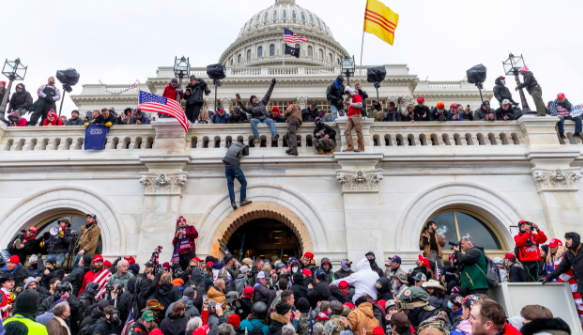
By Sophia Lewis (V)
On January 6, supporters of President Donald Trump gathered in Washington, D.C., to protest the Congressional certification of the 2020 presidential election. Following the rally, a group of rioters stormed the Capitol Building. Four rioters and one Capitol Police officer died as a result of this assault.
The protestors had arrived in D.C. bearing signs and wearing shirts that read “Trump 2020” and “Stop the Steal.” After initially protesting outside the White House, they were greeted by President Trump, who demanded that Vice President Mike Pence and other members of Congress seek to overturn the election results. Following Trump’s speech, the rioters pushed through a barricade and stormed the Capitol. They broke windows, released chemical gas in the hallways, and vandalized congresspeople’s offices, most notably that of House Speaker Nancy Pelosi. Some even made it into the House Chamber, where one rioter stole a lectern. The Capitol had to be evacuated, and pictures of congressmen and congresswomen hiding between seats in the Chamber quickly circulated.
The riot, which was broadcasted on nearly every news outlet, left many people in the Pingry community feeling shocked, appalled, and angry. That night, as Congress resumed the vote count, Head of School Matt Levinson emailed the community, condemning the riot and discussing the Honor Code in the context of American democracy. “The concepts embodied in [the Honor Code] are timeless, particularly…working for the common good rather than solely for personal advantage.”
It was then announced that there would be two processing sessions to be held the next day during the first two class periods. The sessions welcomed hundreds of Pingry students and faculty members, and even as Zoom calls capped at 400 participants, community members listened in through phone calls and FaceTime. There were a multitude of emotions during these sessions. Many students were angry and upset, with a few close to tears. Some chose to share their personal experiences, while others chose to listen. Many students’ common frustration was the Capitol Police’s lack of response to the rioters in comparison to their response to the Black Lives Matter protests that took place over the summer, where swarms of guards lined the Capitol steps. Many students also expressed disgust over Confederate flags and anti-Semitic articles of clothing (such as a “Camp Auschwitz” sweatshirt) making it into the Capitol.
In addition to the processing sessions, there was another session held by Mr. Honohan, where he provided students with an overview of the events leading up to January 6, to help them understand why and how the riots occurred. He also discussed the constitutional issues surrounding the election and why President Trump had called for his supporters to protest in D.C. on January 6. Mr. Honohan stated that he “hope[d] that by providing background information, students would feel better equipped to process the events that occurred.” During CP, Mr. Levinson held separate meetings with upperclassmen and underclassmen to share his thoughts on the event.
Overall, many in the Pingry community were pleased with the swift response. One thing that stood out was that, even during normal class time, teachers chose to bring up the subject and give students a space to process the event, showing the solidarity we have as a community.
